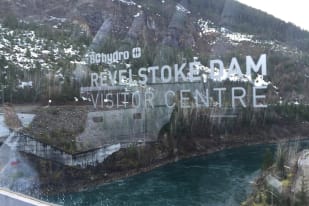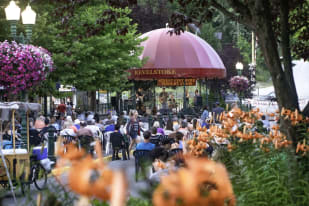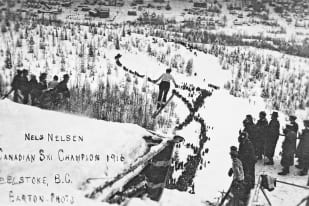Revelstoke Museum and Archives documents the history of a mountain town shaped by the railway, resource industries, and outdoor recreation. Through exhibits, photographs, and personal stories, the museum preserves the experiences of Indigenous communities, early settlers, and workers who built the region. Visitors can explore how Revelstoke evolved, from its industrial roots to its status as a hub for adventure and tourism.
The Story of Revelstoke

Revelstoke Museum and Archives collects, preserves, and shares the history of a town shaped by the Canadian Pacific Railway, logging, mining, and skiing. The museum provides a detailed record of how the region has changed, from early Indigenous communities to modern outdoor recreation. Every exhibit and artifact contributes to understanding how people lived, worked, and adapted to the challenges of a mountain environment.
Located in a heritage building on First Street West, the museum presents stories of those who built the town, from railway workers and business owners to families who arrived generations ago. Photographs, documents, and everyday objects show how the community evolved. Visitors can explore displays on early transportation, wartime efforts, and industries that supported the town’s economy.
How the Museum Began

The museum opened in 1960 to preserve historical records and artifacts before they were lost. It started as a small collection, relying on donations from local families. Over time, it expanded into a professional institution with curated exhibits, educational programs, and digital archives. The building itself, originally a post office, reflects architectural styles from the early 20th century.
As Revelstoke grew, so did the museum’s role. It documents changes in the town’s economy, landscape, and demographics. Historical records show how industries like forestry and tourism reshaped daily life. Interviews and personal accounts capture the voices of long-time residents and newcomers alike.
Permanent Exhibits

Early Settlers and Indigenous History
The museum highlights the presence of the Sinixt people, who lived in the Columbia River Basin for thousands of years. Artifacts, oral histories, and interactive elements illustrate their culture, traditions, and relationship with the land. The exhibit includes audio recordings of the Sinixt language and the scent of cedar, an important material in their daily lives.
European settlers arrived in the late 1800s, drawn by the railway and natural resources. Displays show how they built businesses, schools, and homes while adapting to harsh winters and remote conditions. Maps, letters, and personal belongings tell their stories.
The Railway and Economic Growth
The Canadian Pacific Railway played a central role in Revelstoke’s development. The museum presents the construction of the railway, its impact on local industries, and how it connected the region to the rest of Canada. Uniforms, tools, and photographs provide a detailed look at railway operations and the lives of the workers who kept trains running.
The museum also covers other industries that shaped the town, including mining, logging, and hydroelectric development. Equipment, contracts, and newspaper clippings document economic booms and downturns.
War Efforts and Local Contributions
Revelstoke’s role in World War I and World War II is explored through letters, medals, and photographs. The museum shares the experiences of local soldiers, their families, and the community’s support efforts. Stories include personal accounts from those who served and the challenges they faced upon returning home.
Skiing and Outdoor Recreation
Revelstoke is known for skiing, and the museum tracks the sport’s growth in the region. Early ski clubs, competitions, and the development of ski resorts are covered with vintage equipment, trophies, and posters. The exhibit connects the past to present-day skiing culture, showing how the sport became a defining part of the town’s identity.
Special Exhibits and Programs

Stories Beneath the Surface
This exhibit examines the impact of the Columbia River’s damming and flooding on local communities. Photographs and testimonies show how entire settlements were displaced, altering the landscape and people’s way of life. The project preserves memories of places that no longer exist.
Reclaimed Voices
This ongoing exhibit focuses on marginalized groups in Revelstoke’s history, including Chinese and Japanese immigrants, women in industry, and working-class communities. Documents and interviews reveal stories often left out of mainstream narratives.
Brown Bag History Talks
Every two weeks, the museum hosts lunchtime talks on local history. Topics range from early businesses to environmental changes. These sessions encourage discussion and community engagement.
Guided Walking Tours
The museum offers tours of downtown Revelstoke, highlighting historic buildings, significant events, and changes over time. The cemetery tour introduces visitors to notable figures buried there, sharing their stories and contributions.
Community and Support

The museum relies on volunteers, members, and donors. Volunteers assist with research, events, and preservation work, and memberships provide benefits such as free admission and access to exclusive events. Donations help maintain exhibits and fund new projects. Local schools collaborate with the museum for educational programs that align with curriculum requirements, using hands-on activities and storytelling sessions help students connect with the past.
Why It Matters

Revelstoke’s history is shaped by those who lived and worked there, and the Museum and Archives ensure that their stories are preserved and shared. It connects past and present, giving visitors a clear sense of how the town evolved. Exploring its exhibits provides a better understanding of the people and events that shaped Revelstoke into what it is today.





